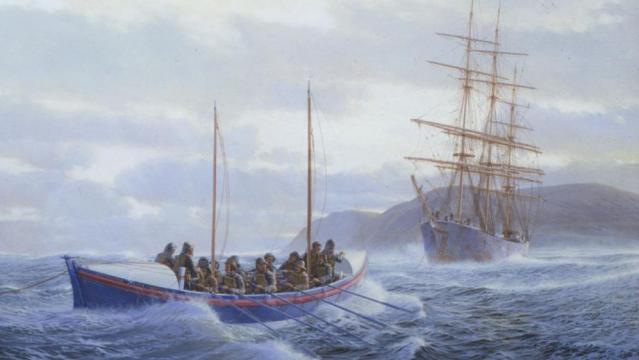Built and launched in Liverpool in 1883, the Forrest Hall was a three masted, iron hulled ship, 277 feet long with a gross tonnage of 2.052, capable of carrying over 3,000 tons of coal in her hold. In early January 1899 she set out from Avonmouth Docks to Liverpool for a refitwithout cargo, only ballast, and with a skeleton crew of eighteen including five apprentice sailors instead of its usual complement of twenty-five, towed by a tugboat, the Jane Joliffe.
A ferocious storm force 9 gale blew up and the tug’s captain wanted to return to Bristol, but the Captain of the Forrest Hall, believed to be James Alliss,could not see the frantic signals because of the poor visibility. The tow rope then snapped when they were west of Lundy Island, the two vessels collided and the Forrest Hall lost its rudder.
Despite lowering its two anchors, as night fell on Thursday January 12, 1899, the Forrest Hall was driven by the power of the storm towards Porlock Bay and the low lying rocks off Hurlstone Point. By this time the Jane Joliffe had lost sight of it and as they later found some damaged steering components floating on the water, assumed that it had foundered on the rocks.
Meanwhile, the crew of the Forrest Hall fired off distress rockets at regular intervals in the hope that they would be seen by one of the RNLI (Royal National Lifeboat Institution) stations along the north Devon coastline. Eventually, Tom Pollard, the local coastguard and landlord of The Lower Ship Inn in Porlock Weir spotted one and sent his son to telegraph the Watchet lifeboat station for assistance.
The storm was so ferocious, though, that the Watchet lifeboat was unable to launch and so another telegram was sent, this time to the Lynmouth Lifeboat Station, received at 7.52pm, reporting that the Forrest Hall was drifting dangerously towards Porlock Weir.
Conditions were just as bad at Lynmouth, with houses, shops and the lifeboat station on the shorefront already flooded, and the crew concluded that they could not safely launch from the harbour. It was then that the coxswain, Jack Crocombe, came up with the idea of taking the lifeboat, Louisa, overland to Porlock Weir which was sufficiently sheltered to allow a safe launch. After all, it was only a journey of 13 miles to be undertaken in one of the worst storms in living memory hauling a thirty-four foot long boat weighting 10 tons up and down Countisbury Hill with its 1 in 4 gradient over some 434 metres and a trek across Exmoor.
Undaunted by the prospects of this Herculean task, over 100 locals, including women and children, quickly assembled, a team of eighteen horses was attached to the lifeboat’s Carriage, and the slow ascent up Countisbury Hill began. Some men were sent ahead to widen parts of the track across the moor and two men were assigned the critical task of keeping the lamps alight. The rest pushed the carriage to help the horses to cope with the hill.
At the summit, the first of a number of setbacks occurred; a wheel came off the carriage, fortunately, near the Blue Ball Inn. Some welcome ale was imbibed while the wheel was repaired. As the most difficult part of the task had been successfully accomplished, it seemed, the majority of the volunteers returned home, leaving just twenty, including the lifeboat crew of fourteen, to carry on.
Near Ashton the track was too narrow for the carriage to pass laden with its cargo. The men lifted Louisa off the carriage, manhandled it with the aid of skids through the narrow passage, and then placed it on the carriage once more. The descent was just as hazardous as the ascent, but once this was accomplished they met their next difficulty. A garden wall restricted the width of the lane to such an extent that the carriage could not pass. The problem was resolved by knocking down part of the offending wall.
Even on the relatively flat track between Porlock to the Weir, they found that the carriage was too tall to pass under a tree. Naturally, some of the group simply felled the tree. They finally reached the Weir at 6.30am where, despite being hungry and exhausted, the crew immediately launched the Louisa, and rowed out to the Forrest Hall, a journey that took around an hour, battling through ferocious winds and rough seas.
This post first appeared on Windowthroughtime | A Wry View Of Life For The World-weary, please read the originial post: here

